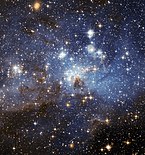
Back دالة الكتلة الأولية Arabic Funkcija početne mase BS Funció de massa inicial Catalan Ursprüngliche Massenfunktion German Función de masa inicial Spanish Fonction de masse initiale French Funzione di massa iniziale Italian 初期質量関数 Japanese 초기질량함수 Korean Fungsi jisim awal Malay
| Star formation |
|---|
 |
| Object classes |
| Theoretical concepts |
In astronomy, the initial mass function (IMF) is an empirical function that describes the initial distribution of masses for a population of stars during star formation.[1] IMF not only describes the formation and evolution of individual stars, it also serves as an important link that describes the formation and evolution of galaxies.[1]
The IMF is often given as a probability density function (PDF) that describes the probability of a star that has a certain mass during its formation.[2] It differs from the present-day mass function (PDMF), which describes the current distribution of masses of stars, such as red giants, white dwarfs, neutron stars, and black holes, after some time of evolution away from the main sequence stars and after a certain amount of mass loss.[2][3] Since there are not enough young clusters of stars available for the calculation of IMF, PDMF is used instead and the results are extrapolated back to IMF.[3] IMF and PDMF can be linked through the "stellar creation function".[2] Stellar creation function is defined as the number of stars per unit volume of space in a mass range and a time interval. In the case that all the main sequence stars have greater lifetimes than the galaxy, IMF and PDMF are equivalent. Similarly, IMF and PDMF are equivalent in brown dwarfs due to their unlimited lifetimes.[2]
The properties and evolution of a star are closely related to its mass, so the IMF is an important diagnostic tool for astronomers studying large quantities of stars. For example, the initial mass of a star is the primary factor of determining its colour, luminosity, radius, radiation spectrum, and quantity of materials and energy it emitted into interstellar space during its lifetime.[1] At low masses, the IMF sets the Milky Way Galaxy mass budget and the number of substellar objects that form. At intermediate masses, the IMF controls chemical enrichment of the interstellar medium. At high masses, the IMF sets the number of core collapse supernovae that occur and therefore the kinetic energy feedback.
The IMF is relatively invariant from one group of stars to another, though some observations suggest that the IMF is different in different environments,[4][5][6] and potentially dramatically different in early galaxies.[7]
- ^ a b c Scalo, JM (1986). Fundamentals of Cosmic Physics (PDF). United Kingdom: Gordon and Breach, Science Publishers, Inc. p. 3. Retrieved 28 February 2023.
- ^ a b c d Cite error: The named reference
Chabrier03was invoked but never defined (see the help page). - ^ a b "Astronomy 112: Physics of Stars -n Class 19 Notes: The Stellar Life Cycle" (PDF). University of Carlifornia, Santa Cruz. Archived from the original (PDF) on 6 April 2023. Retrieved 23 December 2023.
- ^ Conroy, Charlie; van Dokkum, Pieter G. (2012). "The Stellar Initial Mass Function in Early-type Galaxies From Absorption Line Spectroscopy. II. Results". The Astrophysical Journal. 760 (1): 71. arXiv:1205.6473. Bibcode:2012ApJ...760...71C. doi:10.1088/0004-637X/760/1/71. S2CID 119109509.
- ^ Kalirai, Jason S.; Anderson, Jay; Dotter, Aaron; Richer, Harvey B.; Fahlman, Gregory G.; Hansen, Brad M.S.; Hurley, Jarrod; Reid, I. Neill; Rich, R. Michael; Shara, Michael M. (2013). "Ultra-Deep Hubble Space Telescope Imaging of the Small Magellanic Cloud: The Initial Mass Function of Stars with M < 1 Msun". The Astrophysical Journal. 763 (2): 110. arXiv:1212.1159. Bibcode:2013ApJ...763..110K. doi:10.1088/0004-637X/763/2/110. S2CID 54724031.
- ^ Geha, Marla; Brown, Thomas M.; Tumlinson, Jason; Kalirai, Jason S.; Simon, Joshua D.; Kirby, Evan N.; VandenBerg, Don A.; Muñoz, Ricardo R.; Avila, Roberto J.; Guhathakurta, Puragra; Ferguson, Henry C. (2013). "The Stellar Initial Mass Function of Ultra-faint Dwarf Galaxies: Evidence for IMF Variations with Galactic Environment". The Astrophysical Journal. 771 (1): 29. arXiv:1304.7769. Bibcode:2013ApJ...771...29G. doi:10.1088/0004-637X/771/1/29. S2CID 119290783.
- ^ Sneppen, Albert; Steinhardt, Charles L.; Hensley, Hagan; Jermyn, Adam S.; Mostafa, Basel; Weaver, John R. (2022-05-01). "Implications of a Temperature-dependent Initial Mass Function. I. Photometric Template Fitting". The Astrophysical Journal. 931 (1): 57. arXiv:2205.11536. Bibcode:2022ApJ...931...57S. doi:10.3847/1538-4357/ac695e. ISSN 0004-637X. S2CID 249017733.
© MMXXIII Rich X Search. We shall prevail. All rights reserved. Rich X Search